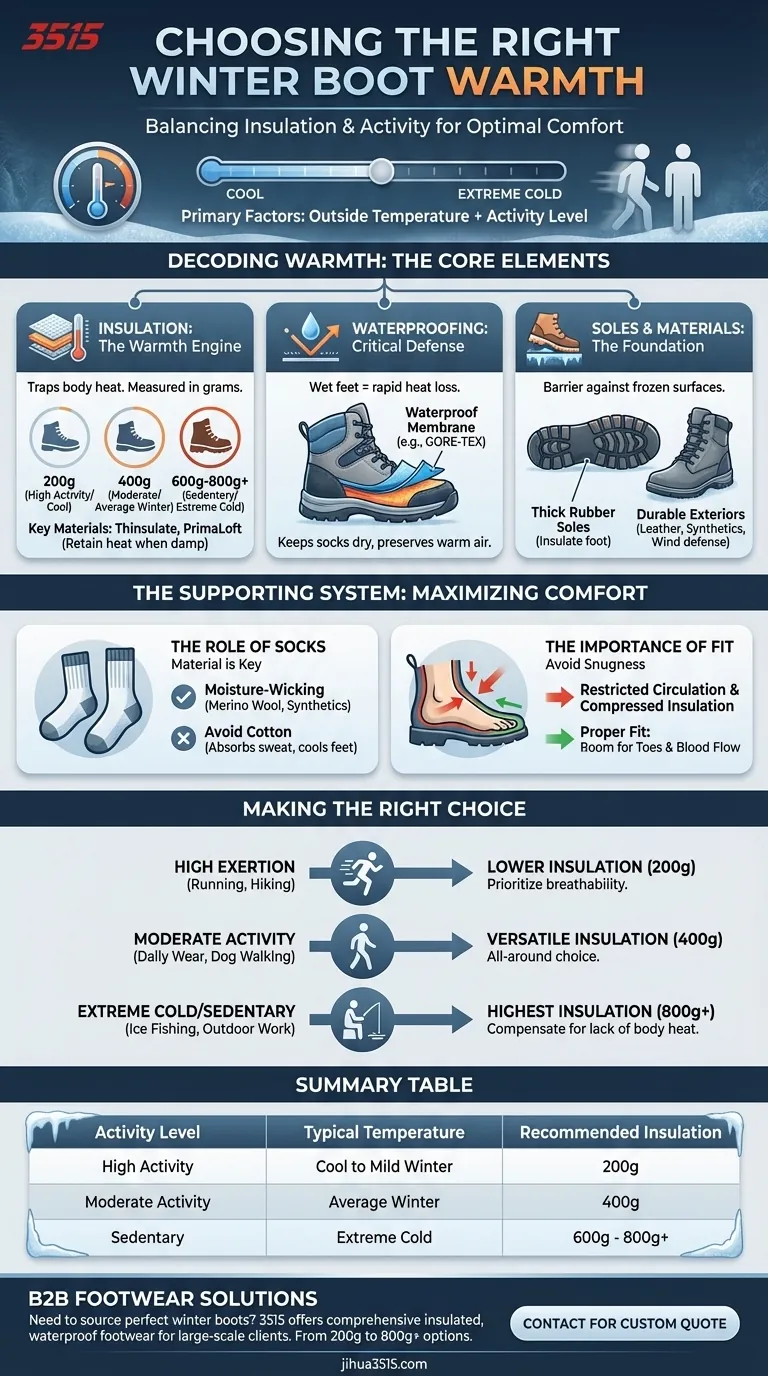To determine the appropriate warmth for winter boots, you must primarily consider the anticipated outside temperature and your planned activity level. These two factors will guide your choice of insulation, which is typically measured in grams. For casual, moderate activity in cool weather, 200 grams of insulation is a common baseline, while stationary activities in extreme cold can demand 800 grams or more.
The core challenge isn't just finding a "warm" boot, but finding a boot that balances insulation against the heat your own body will generate. Over-insulating for your activity level can be just as problematic as under-insulating, leading to sweaty, cold feet.

Decoding the Elements of Warmth
To make an informed decision, you need to understand how a boot creates and maintains warmth. It's a system of interacting components, not just one feature.
Insulation: The Primary Warmth Engine
Insulation works by trapping air, which is then warmed by your body heat. The amount of insulation is a key indicator of a boot's potential warmth.
- 200g Insulation: Best for high-activity use (like winter hiking) or for cool, mild winter days. This amount prevents overheating during strenuous movement.
- 400g Insulation: The "all-around" choice for moderate activity in average winter conditions. It's suitable for tasks like shoveling snow or brisk walks in the cold.
- 600g - 800g+ Insulation: Reserved for very cold temperatures or sedentary activities like ice fishing or spectating at winter events. This level is crucial when your body isn't generating much of its own heat.
Common insulation materials include synthetics like Thinsulate and PrimaLoft, which are popular because they retain insulating properties even when damp.
Waterproofing: The Critical Defense
Wet feet lose heat dramatically faster than dry feet. Effective waterproofing is non-negotiable for true winter performance.
A waterproof membrane (like GORE-TEX) or a fully waterproof construction prevents snow, slush, and water from reaching your socks, thereby preserving the trapped warm air inside the boot.
The Foundation: Soles and Materials
The part of the boot in direct contact with the cold ground plays a vital role in preventing heat loss.
- Thick Rubber Soles: Materials like vulcanized rubber act as a barrier, insulating your foot from the frozen ground. A thick sole creates more distance and protection.
- Durable Exteriors: Materials like leather and robust synthetics provide an initial layer of defense against wind and cold, contributing to the overall warmth of the boot system.
The Supporting System: Factors You Control
The boot itself is only part of the equation. How you wear it is just as important for maximizing warmth and comfort.
The Role of Socks
The right socks are a critical component of your boot system.
- Material is Key: Choose moisture-wicking materials like merino wool or high-quality synthetics. These pull sweat away from your skin, keeping your feet dry.
- Avoid Cotton: Cotton absorbs moisture and holds it against your skin, rapidly cooling your feet and defeating the purpose of an insulated boot.
The Importance of Proper Fit
A boot that is too tight can be a significant problem in winter.
- Restricted Circulation: A snug fit can constrict blood flow, which is essential for keeping your extremities warm.
- Compressed Insulation: An overly tight fit can also compress the boot's insulation, reducing its ability to trap air and keep you warm. Always ensure you have room to wiggle your toes.
Making the Right Choice for Your Goal
Ultimately, the "best" boot is the one that matches your specific context. Use your primary use case as your guide.
- If your primary focus is high-exertion activity (winter running, hiking): Opt for lower insulation (200g) and prioritize breathability to manage sweat.
- If your primary focus is daily wear and moderate activity (commuting, walking the dog): A 400g insulated, waterproof boot offers the most versatility for typical winter conditions.
- If your primary focus is staying warm in extreme cold with little movement (ice fishing, outdoor work): Choose the highest insulation level you can find (800g+) to compensate for the lack of body heat generation.
Matching the boot's features to your activity and environment is the definitive path to warm, comfortable feet all winter.
Summary Table:
| Activity Level | Typical Temperature | Recommended Insulation |
|---|---|---|
| High Activity (e.g., hiking) | Cool to Mild Winter | 200g |
| Moderate Activity (e.g., dog walking) | Average Winter | 400g |
| Sedentary (e.g., ice fishing) | Extreme Cold | 600g - 800g+ |
Need to source the perfect winter boots for your customers? As a large-scale manufacturer, 3515 produces a comprehensive range of insulated, waterproof footwear for distributors, brand owners, and bulk clients. Our production capabilities encompass all types of insulated boots, from 200g for active use to 800g+ for extreme conditions. Let us help you find the ideal balance of warmth, durability, and value for your market. Contact our team today for a custom quote!
Visual Guide

Related Products
- Safety Footwear Wholesale Manufacturer for Custom OEM/ODM Production
- Premium Wholesale Waterproof Safety Boots High Performance Protection for Industrial Markets
- Wholesale Safety Footwear Manufacturer for Bulk & Custom OEM Orders
- Custom Wholesale Leather Safety Boots Direct Factory Manufacturing
- Customizable Anti-Smash Safety Boots for Wholesale & Private Label Manufacturing
People Also Ask
- Is safety-toe as good as steel toe? Choose the Right Protection for Your Job
- Do snake bite boots work? Your Ultimate Guide to Effective Snake Bite Protection
- What are OSHA approved shoes? Understanding the Correct Standards for Workplace Safety
- Is it normal to wear shoes in the house? A Guide to Hygiene, Comfort & Culture
- What cultural and environmental considerations are tied to wearing shoes indoors? Balance Hygiene, Tradition, and Foot Health



















